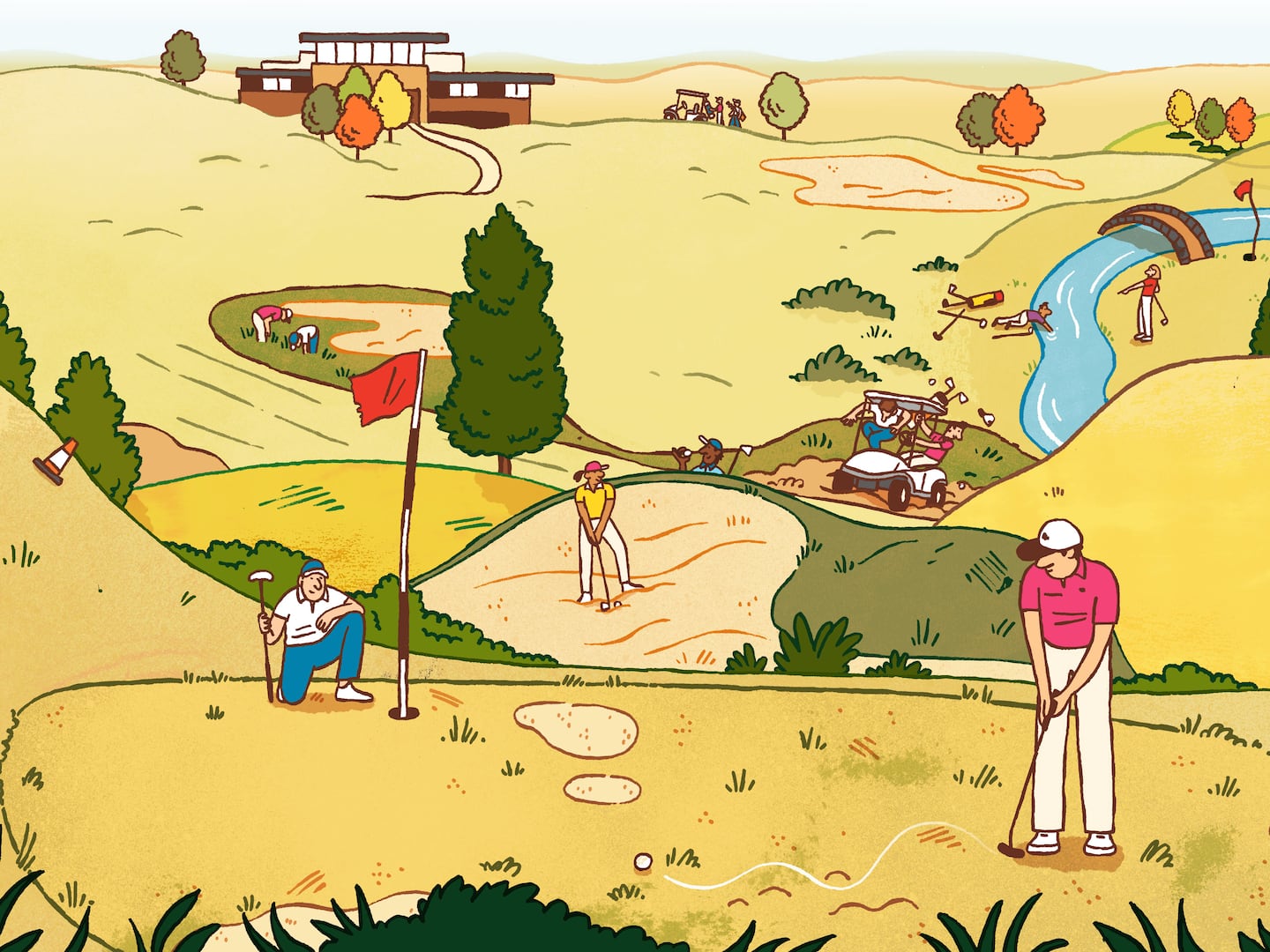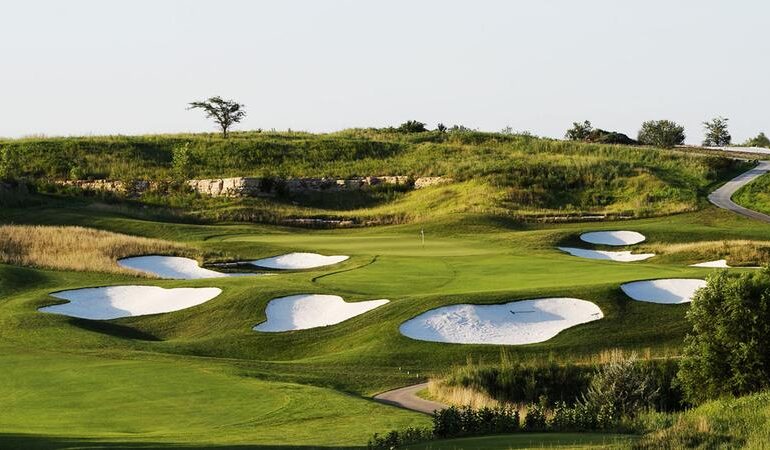So here are 18 thoughts from my round at the place regulars call “Leo J.”
1. The first thing I notice, while walking up from the parking lot, is the clubhouse. It looks like Frank Lloyd Wright got a commission from the Metropolitan District Commission in the 1970s, and was told, “All we have is fifty bucks and some red bricks. See what you can do.” Those familiar with the work of the now-defunct MDC, which once managed all of Greater Boston’s recreational facilities (a job that now falls to the Department of Conservation and Recreation) will understand what I mean.
Regardless, I’m so distracted that I did not notice the practice green just next to the building. This was a good thing.
2. It costs $19 to play nine holes at Leo J. I pay $30 for all 18, as does my playing partner for the day, my friend Mark Horgan. If you are unfamiliar with golf pricing, this is like looking at an old photo of a gas station where the sign says a gallon costs 89 cents.
Inside the clubhouse, the guy who checks us in has just finished smoking a cigarette. He tells us his life story. When I tell him I’m a reporter investigating America’s alleged worst golf course, he says he does not want his name in the article. I don’t think I’m betraying him by pointing out his observation that the course is priced accurately.
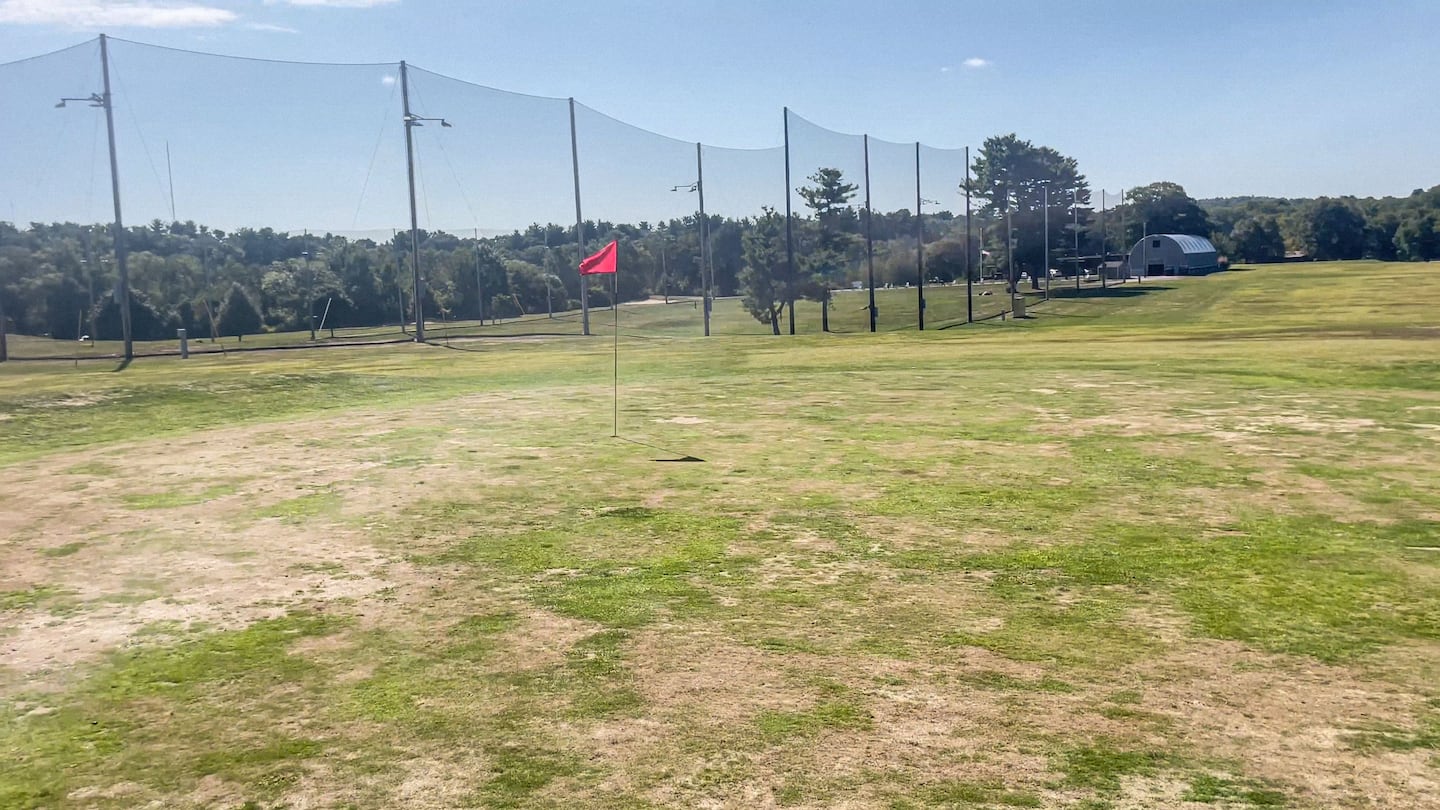 The green on the first hole at the Leo J. Martin Memorial Golf Course with the driving range in the background.Billy Baker/Globe staff
The green on the first hole at the Leo J. Martin Memorial Golf Course with the driving range in the background.Billy Baker/Globe staff
3. The first tee is not the ugliest I’ve hit from. Typically, the opening hole is all about getting away from the busiest part of the course, nearest the road, and heading off into the property. At Leo J., it’s a 325-yard par 4 with Park Avenue in Weston on the left and the big net surrounding the driving range on the right. The first hole and the driving range hit up the same hill, which in the winter is used for cross-country skiing and sledding.
4. The driving range makes more money than the course, but the course still makes money. These facts are repeated to me by each of the passionate regulars I meet. These golfers are angry about several things, but their biggest gripe is that any profits from DCR facilities go into the state general fund, and not back into maintaining the golf course. I’ll learn about the other things they are angry about soon enough.
5. My tee shot lands in the short rough on the left side of the fairway, leaving about 100 yards to the flag, slightly uphill. I smash a wedge that, strangely, seems to go exactly where I intend. It lands a few feet from the hole and does not move. It lands like it got stuck.
6. What I see when I get up the hill deserves awe and admiration. It’s not fair to call it a green — that is not its primary color. It’s brown, with quite a bit of desert thrown in. I suspect it has mange. It has more rocks than blades of grass. You cannot make a worse green. You could only hope to tie.
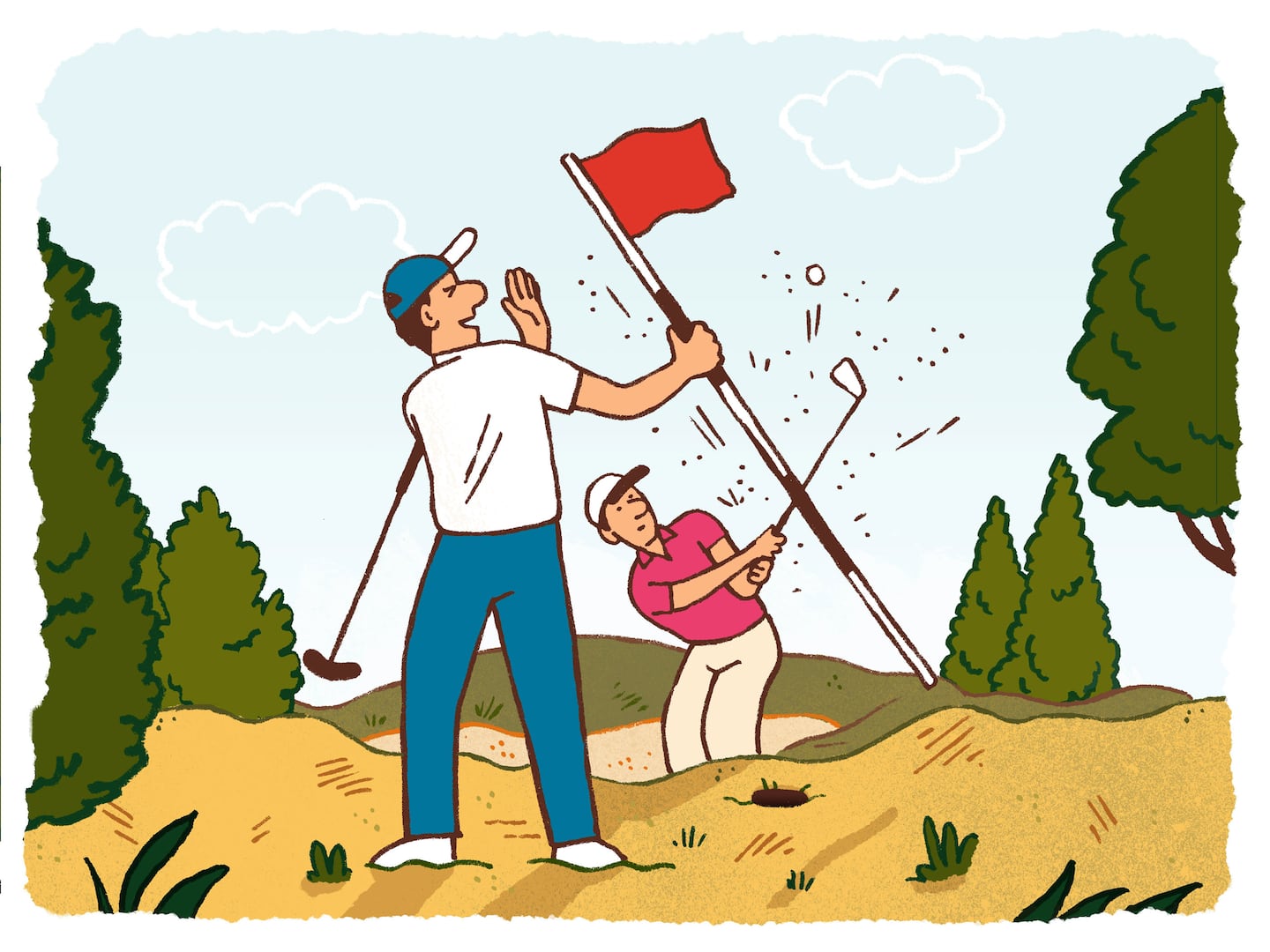 Michael Parkin for The Boston Globe
Michael Parkin for The Boston Globe
7. The MyGolfSpy ranking was based on Google reviews, and those are spectacularly bad for Leo J. It’s worth pointing out that Massholes are extraordinarily gifted at complaining, which might have something to do with the fact that three Bay State courses made the list of the 10 worst, including the only other state-run course, Ponkapoag Golf Course in Canton (fifth worst), as well as Norwood Country Club (third worst).
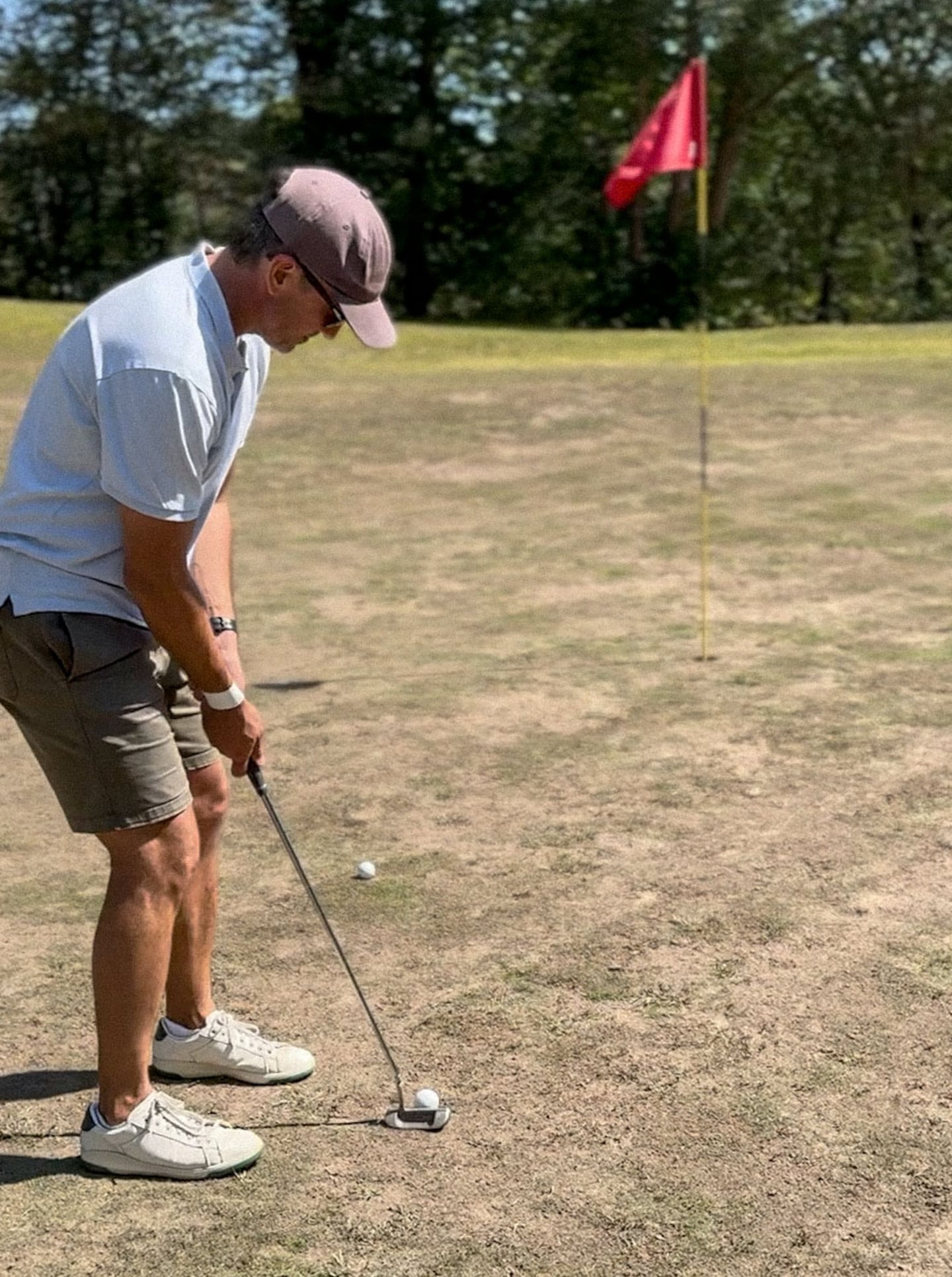 Billy Baker putting at the Leo J. Martin Memorial Golf Course.Mark Horgan
Billy Baker putting at the Leo J. Martin Memorial Golf Course.Mark Horgan
8. Putting, in the traditional sense, does not work at Leo J. Where you aim the ball and how hard you hit it are only the beginning of the equation, because both are moot as soon as you hit your first obstacle. And you’re going to hit several.
I think I can power over them with my first putt, but it rolls well past the hole, and as I walk to my second, even longer putt, I can see how it does work at Leo J., which is not uninteresting. Where a typical green asks you to judge how a ball will behave on a slope, here you must judge how it’s going to behave after it hits a clump of crabgrass, then a rock, then crosses a small stretch of the Australian Outback.
9. I was wrong: The second green somehow manages to be worse than the first, but it looks like the South Lawn of the White House compared with number three. This hole is not just bad; it’s disappointing.
I say this because it’s actually interesting — a short par 3 to a sandy hump about 130 yards away. There’s a large bunker just before the green on the left, and it’s open on the right, and both leave a steep chip up to the green, which is definitely not green.
As I stand on the tee box, I can for the first time feel Leo J.’s design poking out. Built in 1930, the course, originally called Riverside Golf Course, is carved out of a rolling area along the Charles River, across three of the toniest towns in Massachusetts. It was placed in the hands of Donald Ross, the acclaimed architect of hundreds of courses, including icons such as Pinehurst No. 2 in North Carolina and the East and West courses at Oak Hill in New York, as well as local gems George Wright in Hyde Park and Essex County Club in Manchester-by-the-Sea. “His stamp as an architect was naturalness,” the famed golfer (and course designer) Jack Nicklaus once said. Ross’s signature was what is known as a “turtleback” green, with the highest point in the center, exactly like the one I am staring at.
But this turtle looks like it is dead and the sea gulls have gotten at it. I make a note to visit Ross’s grave, a short distance away in Newton Cemetery, and leave a note of apology. I should also leave one at the grave of Leo J. Martin, a former amateur state golf champion who had the course named for him after he died in World War II.
This is not the country’s worst course, I think. It’s the most disrespected.
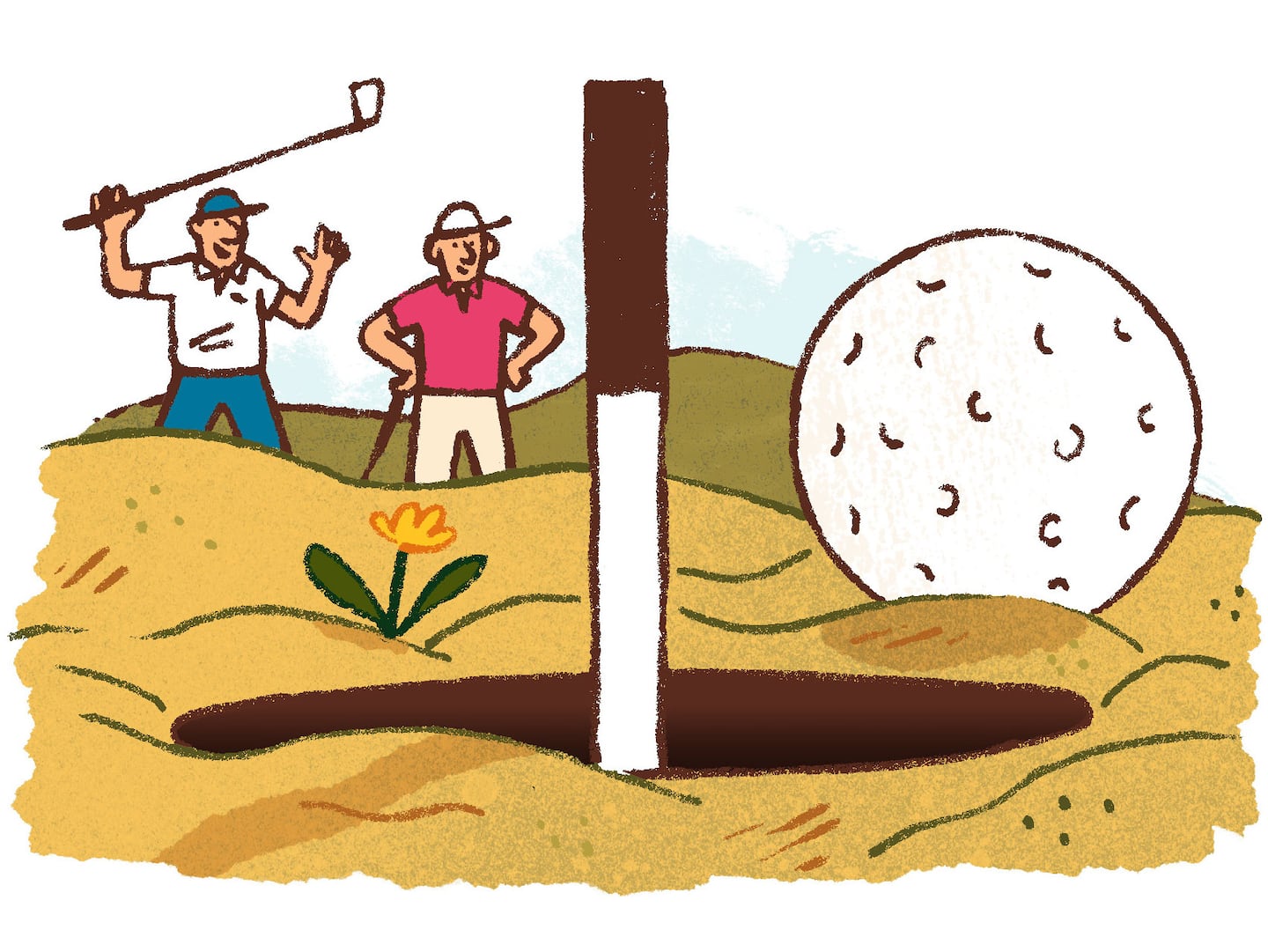 Michael Parkin for The Boston Globe
Michael Parkin for The Boston Globe
10. “It’s a shame it’s in the shape it is right now,” says Justin Grimes, the newly-appointed director of golf course maintenance for the DCR. He took his job just a few days before the list came out, and says the state was more than aware of the condition of Leo J. and “Ponky.”
“It’s mostly an irrigation issue. It’s ancient. It’s original. It’s from 1930. The superintendent needs to get to work at 2 a.m. to manually turn on each irrigation head if he wants to water the greens. It’s not sustainable.”
DCR is committing to big upgrades, including construction of a new irrigation system planned for next spring and more frequent maintenance such as aeration, fertilization, and seeding. But what’s out here now is an embarrassment — and it’s only getting worse. The first six greens aren’t even suitable to be a dog park, but when we cross the road to play the seventh, I laugh out loud.
There is no green at all. I can’t imagine how bad it was to get cordoned off, but instead they have spray-painted a circle on the fairway and installed a pin.
It is the smoothest green I’ll play all day.
11. It is around here that I begin feeling thankful I decided to bring along Mark, a buddy from Gloucester who holds his own No. 1 ranking — he is the most positive person I know. He likes everything and everyone and vibrates at a frequency several decibels above the safe range. He is a devotee of sunrise golf, and once or twice a week he has me standing in the dark with a golf glove on and driver in hand, waiting for shooting hours.
If anyone could find the positive in this, it’s Mr. Brightside. And he does. He loves how inexcusably bad Leo J. is, and we talk about how it’s akin to a dive bar, where the decor is outdated and mismatched, and everyone looks a little grouchy, but the beer is cheap. And on brand, Mark is acting like his beer is ice cold, while mine now feels warm and flat, and there’s a cigarette floating in it.
12. The indignity deepens on the back nine. Here, the course is intersected by a shallow and clear stretch of the Charles River. The water is idyllic and slow, and twice you cross it on a wooden bridge. The layout on these nine holes, starting with a challenging par 3 on the 10th, is a great example of that Ross “naturalness.” While much of the front nine feels like he cleared out trees to make a golf course, the back nine feels like he discovered one that already existed, and just planted some grass. The fairways are narrower with more bends in them, and you feel secluded. And angry. This could be — should be — a diamond in the rough. Instead it’s just … rough.
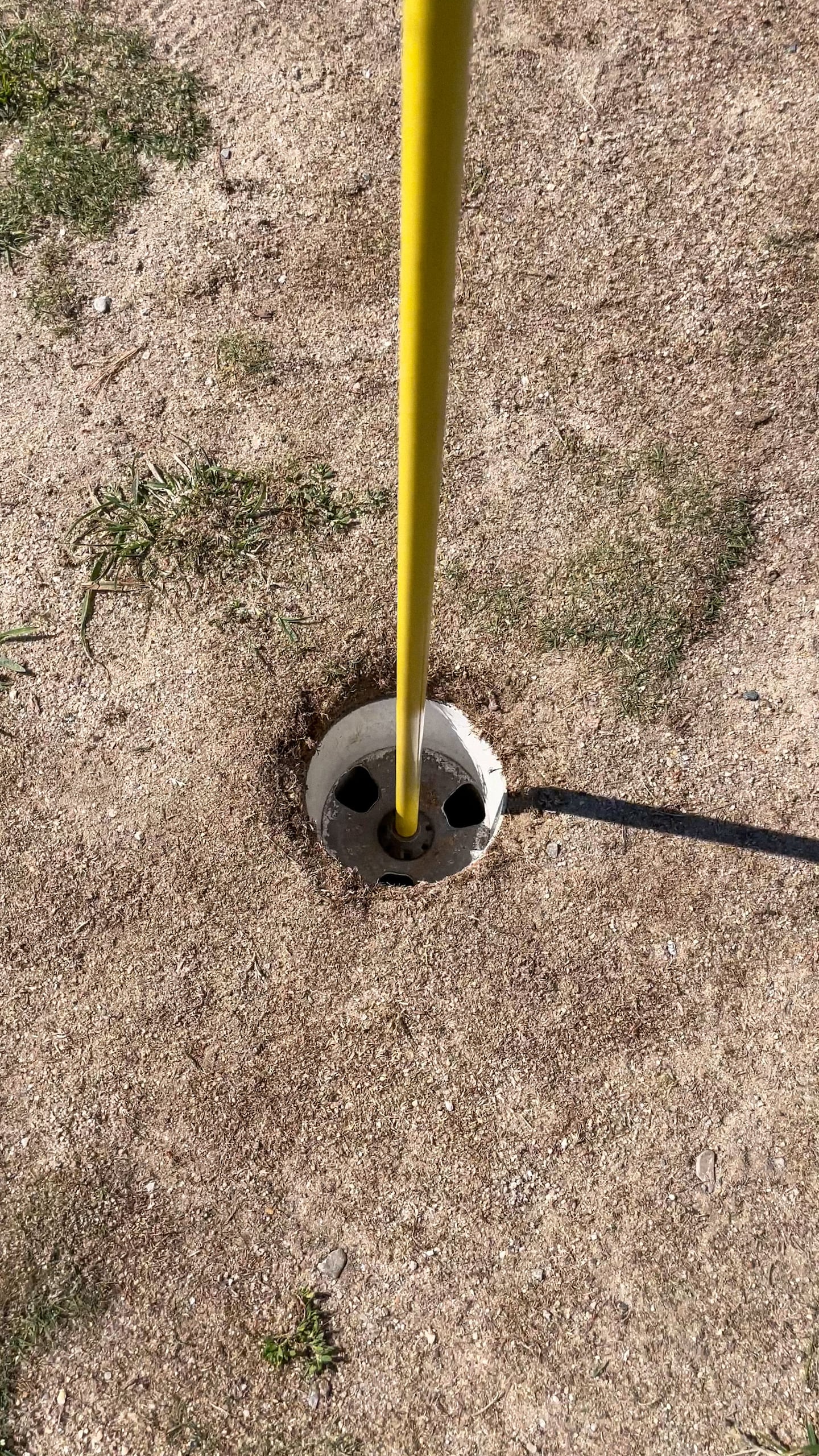 The rim of the cup on the third hole at the Leo J. Martin Memorial Golf Course.Billy Baker/Globe staff
The rim of the cup on the third hole at the Leo J. Martin Memorial Golf Course.Billy Baker/Globe staff
13. The conditions are so bad that I freely allow myself a preferred lie: a rule that courses can institute when they are not in their best condition, such as in winter, when you get to move your ball up to 6 inches to a better spot.
“We call it the Leo J. drop,” a regular named Mike Riseberg tells me later. And it’s always in effect, which is a good thing because there are times when I look down at my ball in a pile of roots and rocks and consider the possibility that I’d break both wrists if I tried to hit it.
Riseberg lives in Newton and grew up just behind the 12th hole in Wellesley. He played here with his father as a kid, and now he plays with his children.
“I love it the way it is,” he says. “The greens could use some care, but then the price goes up, the laid-back attitude changes.”
You just have to play Leo J. rules, he says, which means wherever it lands, you’re entitled to find the nearest plot of grass, which is almost certainly more than 6 inches away. Also, anything above a three-putt is the fault of the greens.
14. Somewhere on the back nine, I figure out that it’s actually possible to two-putt a green at Leo J. The trick is not to aim for the hole, but at the closest patch of sand to the hole — and try to make it get stuck. From there, you have a chance — a slim chance — of actually getting it in.
15. As the round nears its end, I wonder: Is Leo J. the worst golf course in America? And the answer has to be no, because it is not the worst course I’ve ever played. Not by a long shot.
It is in the worst shape, but it’s not uninspired. I’ve played a course in Virginia, where my wife is from, that has several “fairways” that simply follow utility lines built by a power company and the second tee box is right next to people ordering at a Taco Bell drive-thru.
No, the sin of Leo J. is much more sinister — it may be the worst good golf course in America.
16. Steve Condakes, another golfer I meet, pays $875 for a full, seven-day-a-week season ticket to Leo J., and takes advantage of it nearly every day between April and Thanksgiving. He’s been a regular for more than a decade and gets irate when he talks about its condition.
“I just can’t believe the government has allowed this gem to fall into disrepair, unless it’s because lawmakers are worried [about] being seen putting money into a golf course in Weston and Newton and Wellesley.”
17. The fact that this course is in a scenic section of three of the richest towns in America has been part of the fun since the MyGolfSpy list appeared in August. But let’s make something clear: Those towns have the posh, manicured private clubs you’re picturing. This ain’t one of them.
Leo J. is a municipal course. “Munis,” as they are known, are the backbone of golf, owned by cities and towns — nothing fancy, just a way for the masses to play. And they are more necessary now than at any time in golf history. The sport has exploded in popularity since the COVID pandemic, when many discovered that golf was a socially-distant way to take a four-hour walk through a garden with your friends.
And much of that explosion has come from outside the traditional core of golf, which is middle-aged white dudes like me. And that’s who I see at Leo J. — blue-collar workers, women who want to play without feeling like they’re being judged, occasional golfers who just need a place to meet up with a buddy they haven’t seen in a while.
But muni does not need to mean yucky. Boston has two great municipal courses, Franklin Park and George Wright. Like Leo J., they both went through a period of decline, before the city — at the urging of former Mayor Tom Menino — turned them around. In 2021, Golf magazine named George Wright one of the top three municipal courses in America. I’ve played both and they’re well-cared for, affordable, and profitable. It can be done.
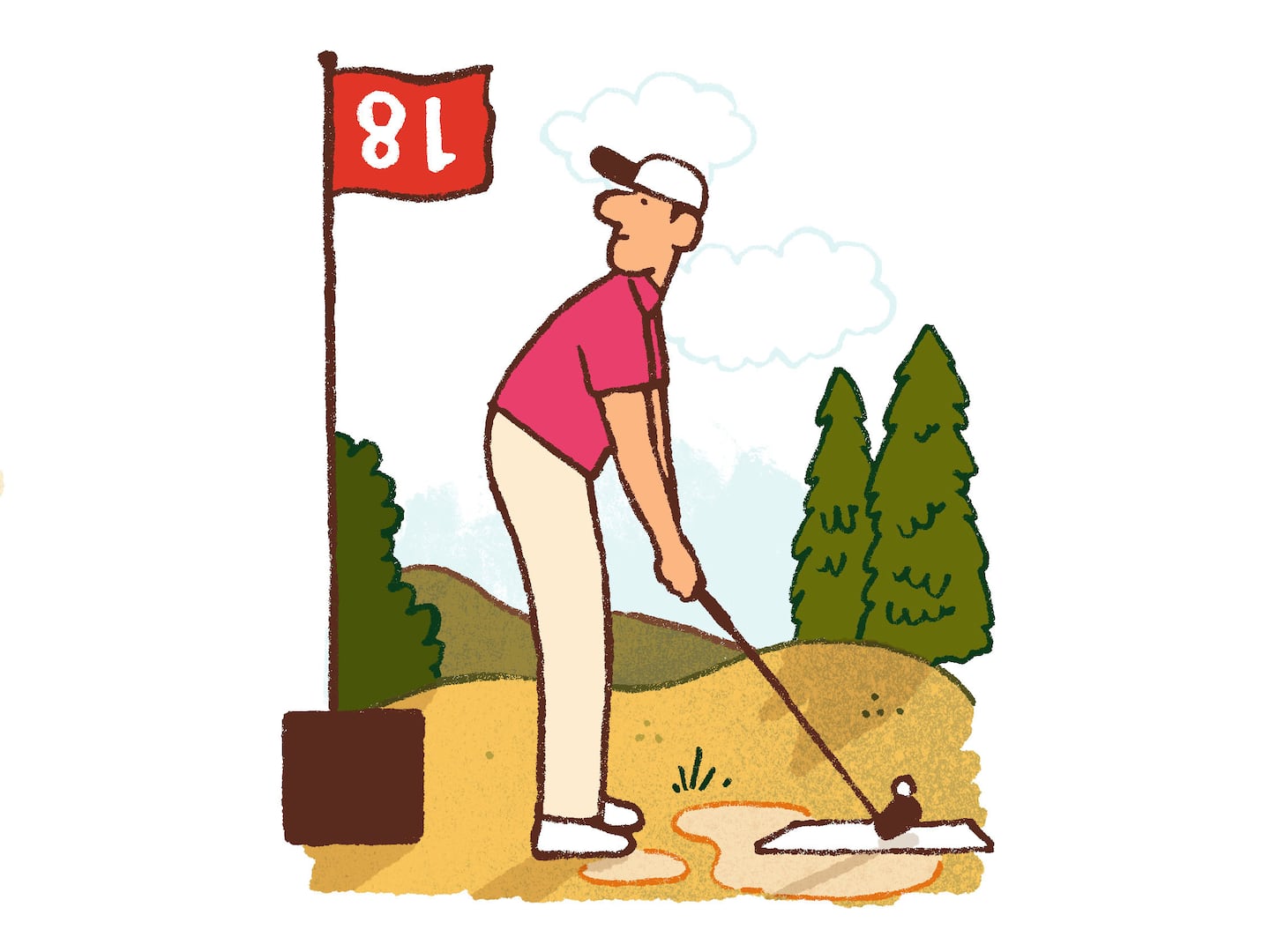 Michael Parkin for The Boston Globe
Michael Parkin for The Boston Globe
18. Arriving at the final tee box, we find the number 18 hanging upside down. This feels fitting. But, unlike the rest of the course, I have no idea how it ended up that way.
And here again, the Golf Gods laugh at me. I’d asked for the worst round of golf I’d ever played, and as we tee off, laughing, I know this was not it. The truth is I’ll never have that day. Golf rarely goes well, and there’s a reason why the joke about it being “a good walk spoiled” never goes out of style.
But the cruelest joke of the Golf Gods is that it’s always fun. Spending time outside, with friends, failing at the simplest of tasks — all of this is why I’m addicted, why I come back and will keep coming back.
Just not at Leo J.
Billy Baker can be reached at billy.baker@globe.com. Follow him on Instagram @billy_baker.

